Supervised by: Yash Salunkhe BSc (Hons). Yash is currently completing his MPhil in Economic Research at the University of Cambridge. He gained his BSc Econometrics and Mathematical Economics (EME) at the London School of Economics (LSE) in 2018. From 2018-19, Yash worked in Venture Capital in Pune, India, evaluating startups with a positive social impact. From 2019-2021, he worked in Wealth Management, helping large institutions invest their portfolios above $25 million. He has co-founded 2 charities: one focuses on improving outcomes in under-funded schools in India and the other was involved in varied community development projects.
“The technology likely to have the greatest impact on the next few decades has arrived. And it’s not social media. It’s not big data. It’s not robotics. It’s not even AI. You’ll be surprised to learn that it’s the underlying technology of digital currencies like Bitcoin. It’s called the Blockchain.”
— Don Tapscott
Blockchain technology has been designed to provide a layer of trust over the internet. This layer of trust is not only enabling many possibilities for different industries but also enhancing their performance by adding fundamentally new capabilities.
Blockchain technology is already the core component of cryptocurrencies, and it is significantly disrupting the payments sector. But blockchain technology has many applications beyond this, and the potential to significantly disrupt many other industries.
Even if digital currencies fade from popular interest or were to be outlawed overnight, blockchain technology is likely here to stay. In this paper, we cover all of the relevant sectors and industries that blockchain tech has the potential to disrupt.
Smart Contracts
Smart contracts are an aspect of the blockchain with potentially significant disruptive applications. Smart contracts are executable functions that run when any preconditions are met. Once deployed through a client, smart contracts are pushed to the most recent blockchain to be stored forever. Typically, the memory address of the stored smart contract is given to the user due to deployment. With the arrival of the Ethereum network on 30 July 2015, smart contracts became a reality (Asharaf, 2017). With the Ethereum networks programming language Solidity, users can write decentralized agreements and push them to the blockchain with the cost of Ether (Ethereum network currency used to pay the gas fees miners get). The contracts can be used to achieve various tasks, including conditional borrowing and lending, or making customized tokens, decentralized apps (dApps), or decentralized autonomous organizations (DAOs) (Asharaf, 2017).
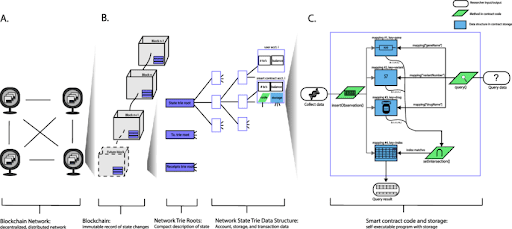
“Ethereum Blockchain and Smart Contracts. A A Blockchain Network …” Accessed August 20, 2022. https://researchgate.net/figure/Ethereum-blockchain-and-smart-contracts-a-A-blockchain-network-consists-of-a_fig1_341834139.
Smart contracts usually come with their respective tokens for users to use as a currency like daily life coins or proof of ownership, like a stock owned by a company. The most commonly used Ethereum smart contract, ERC20, creates fungible (comparable) decentralized tokens that are stored and traded through the Ethereum network, most frequently used to represent Ethereum-based coins. Tokens created using the contracts can not be differentiated because each of the tokens is identical (Modi, 2018). The most popular type of fungible token is called Altcoin (alternative coin), a brand new currency trading in the Ethereum blockchain. Utilizing smart contracts to buy online services through such tokens have the ability to convert our current bank/centralized system to a new blockchain/decentralized system. Currently, the Tether token is the most popular token written in ERC-20, meant to have a stable value of 1.00 dollars (Modi, 2018). Such coins have the direct possibility of replacing all the dollar transactions and moving them to the field of blockchain.
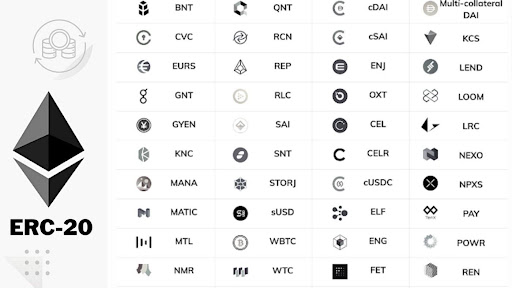
“ERC-20 Token Basics for Crypto Beginners.” Medium. CryptoWise, June 18, 2021. https://medium.com/crypto-wisdom/erc-20-token-basics-for-crypto-beginners-231f988db36.
One type of smart contract is ERC721 token standards which can be used to create non-fungible tokens, NFTs in short. Nonfungible tokens are differentiable from each other, meaning that each of the NFTs, even if they are the same type, are different in some unique properties. This creates endless opportunities to represent physical belonging digitally. Digital art ownership becomes valuable. Digital game items could be securely traded in a matter of seconds. Company stocks or other investment capitals can be quickly and securely exchanged. Digital signed certificates or documents become secure and accessible. Also, NFTs can allow users to share ownership of a specific item. For example, a rare Pokemon card can have 100 copies of an NFT created for it, each representing one percent ownership of the card. This property creates endless opportunities for artists to sell ownership of their art in general, such as a musician selling their music or physical or digital artists selling their paintings. One NFT called the Merge, a series of NFT pictures, sold for 91.8 million dollars in December 2021 (Ng, 2017). The customization of NFTs creates limitless possibilities, because they can replace any item due to their ability to represent anything.
A less publicly known contract, ERC-777, is the upgraded version of ERC20 that allows more complex interactions between Ethereum-based tokens. ERC-777 also comes with backward compatibility with ERC. That means any dApp that works with ERC-20 could also work with ERC-777, and users could easily upgrade their contracts. Their users include but are not limited to sending transaction data, anti-money laundering laws for increased security, and reduced transaction friction by cutting the required transactions to one from two.
Drawing ideas from the former three, the ERC-1155 smart contract allows the representation and control of multiple tokens with a single contract. This approach enables more practical and efficient operations when operating with multiple tokens since everything is stored in a single agreement, thus on the same block of the blockchain. This results in lower time complexity and much lower mining costs when working with multiple tokens (Ng, 2017).
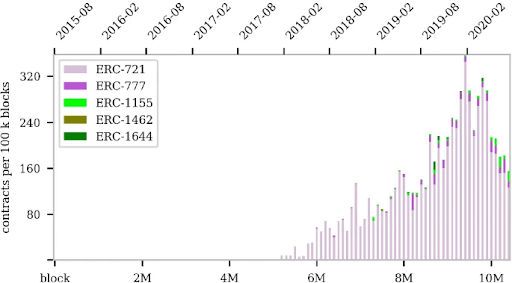
Di Angelo, Monika, and Gernot Salzer. “Identification of Token Contracts on Ethereum: Standard Compliance and beyond – International Journal of Data Science and Analytics.” SpringerLink. Springer International Publishing, March 6, 2022. https://link.springer.com/article/10.1007/s41060-021-00281-1.
Ethereum contracts can also be used to make decentralized organizations (DAOs). Smart contracts can be used to specify the rules organizations will use. Tokens that are sold typically act as company stocks that give the power to the user to make choices about the future of the company, such as how the treasury will be used for the future of the company (Ng, 2017). Currently, Uniswap is the greatest DAO, with a market cap of 5.3 billion dollars as of August 2022.
Ethereum smart contracts are a rapidly developing and dynamic field. There are multiple other smart contracts and more in the state of development. Some of the final (no longer in effect) Ethereum contracts are ERC-3156, a policy for acquiring flash loans; ERC-4626, a policy used for tokenized vaults; and ERC-1363, a policy used for payable tokens. New smart contracts can be added to the next block (“Smart Contracts”). Currently, ERC-20 tokens are the most popular smart contract, constituting 81 percent of the total single calls. Through its introduction of smart contracts, Ethereum massively boosted the interactability of the blockchain system and made it what it is today. Currently, it is the second largest blockchain network with a total market cap of 198 billion dollars as of August 20th, 2022. Due to its dynamic structure and still developing smart contracts, Ethereum and blockchain, in general, is a growing field that can represent all physical belongings and carry them to the digital world to offer secure and utilizable storage, giving access to easier trading, and voting made in a decentralized environment to offer non-government regulated access.
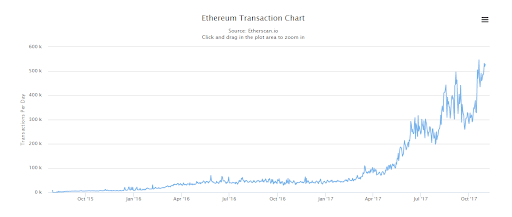
Ikkurty, Sam. “What Is the Potential Growth for Ethereum?” Medium. Medium, July 4, 2018. https://medium.com/@samikkurty/what-is-the-potential-growth-for-ethereum-81cf5c52e09a.
2. Healthcare
Blockchain has been used in a wide range of applications, with an influential impact on healthcare, which allows systems to store medical reports in a confidential way, trace the drug supply chain, and supports monetary transitions between patients and suppliers etc.
To start with, drug traceability is essential for patients’ health. With a reliable drug traceability system, patients and stakeholders of the drug supply chain would be able to keep an eye on the drug transaction flow and drug security could be guaranteed (Huang, Wu, and Long, 2018). Counterfeit products could be eliminated, thus increasing the transparency of the supply chain. For example, Blockpharma, located in Paris, scans the information and resources involved in healthcare from the supplier to customer, and verifies the transportation of products at every point, which notifies patients whether or not they are taking falsified medicine. It claims to isolate 15% of medicine faculty in the world.
Moreover, with the help of a powerful and formidable mechanism, information sharing among industries could be facilitated, and dissimilar electronic health records could be connected, which encourages direct communication between owners and buyers (Pedro et al, 2021).
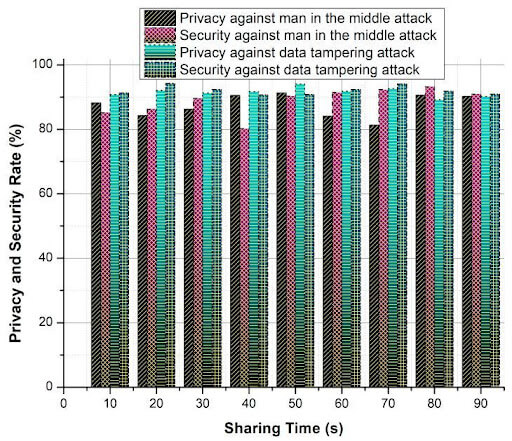
Figure 1 Privacy and security ratio against attacks. <https://pubmed.ncbi.nlm.nih.gov/32751325/>
By developing the Distributed Ledger-based Improved Biomedical Security system (BDL-IBS), privacy and protection of data could be enhanced, as the average rate of privacy and security is over 90% as shown in the figure above (Haibing, Rubén, and Oscar, 2020)
Additionally, blockchain is applied to healthcare security in a lot of companies in the US. For example, Coral Health, which is located in New York, uses blockchain to speed up the care procedure and simplify the management process, thus allowing healthcare suppliers like doctors and technicians to stay connected with patients.
3. Gaming
Blockchain technology has the potential to revolutionize the gaming industry and allow for a more streamlined gaming environment that is more secure and accessible. Through eSports, cross-platform payments, security, and prize pools, this nascent technology has the potential to expand profoundly on this industry.
Currently, the gaming industry is at large a leisure activity, where many play hours of games for fun. The introduction of blockchain technology in the gaming industry could transform it and bring in more value to such a booming market (Attaran et. al. 2019).
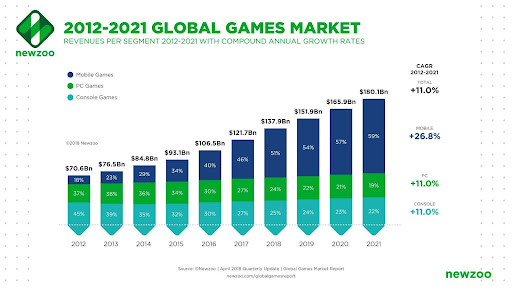
Newzoo image of gaming industry
As depicted by the image, the global market for gaming has increased significantly over the past decade, conveying that the gaming industry is here to stay, and will continue to generate enormous sums of money. In only nine years, the industry has grown by more than $100 billion, and will continue to increase in the future (Takahashi 2021).
Blockchain technology could revolutionize the gaming industry and benefit it through its various applications in the growing sector of eSports. Firstly, due to the scope of the technology, players could transfer various characters into other games using stored data, allowing for less frustration when starting a game. Moreover, digital assets within a game could be stored or sold virtually across games, and with blockchain being decentralized, they would be harder to hack or disrupt. Another key use in gaming is blockchain’s oversight of payments. Centralized companies inherently struggle in the protection of user data, but blockchain technology could solve this problem by allowing for a more streamlined payment process without any personal details needed. Finally within the eSports sector, competitive games are enormous, and with blockchain technology, the stakes of such games could improve with the addition of increased prizes for those who win (Sharma 2018).
One major example in which blockchain technology was successful in regards to its game based technology is with the technology Cryptokitties. These virtual assets have been passed around and traded millions of times. Through one’s respective ledger, they are guaranteed ownership of a virtual asset due to the transparency of the transaction. Moreover, another empirical example is with the hero simulator called CrypticLegends. Many different characters can be used across many games that are being developed, allowing for increased potential of cross-platform sharing. Moreover, in online role-playing games (RPGs), the blockchain technology can be applied in helping resolve the issue of scamming and cheating. For example, if someone were to steal an account within a game, the items or other virtual assets could be returned to the original user, allowing for a more productive and streamlined gaming environment. Also, in terms of privacy, blockchain technology can be used to satisfy the growing desire for transparency and security within games by ensuring that there is no cheating in regard to prizes won within a game (Pfeiffer et. al. 2020).
4. Intellectual Property Protection
Intellectual property protection has been around for centuries. As inventions are thought up, and ideas emerge, there must be a way of crediting the original creator with the design, so that ingenuity can be encouraged and the creator’s work can be protected. Without a fast and secure method of intellectual property protection, creators can see their ideas adopted by large companies with the resources to better streamline the production of their invention, without giving any credit to the original inventor themselves.
The current system of IP protection has been around for a long time, but with technology quickly developing, a new system could be created for the protection of people’s ideas and products.
Here we can use blockchain, a system that involves multiple “blocks” creating a “chain” of data, which can be followed by everyone in the system, to give a transparent and incorruptible set of data that can be inputted and referenced much more quickly than previous systems of data storage.
Blockchain technology can be used to decentralize the process of applying for intellectual property protection. Lots of small businesses and individuals have problems protecting their IP rights, because of the cumbersome and slow bureaucratic system the startup or individual has to navigate, without the backing and authority of a well established and already dominant company to support their ideas. This can be solved by using blockchain technology instead of the old practices of visiting multiple offices to approve a patent.
But what can blockchain do more specifically for intellectual property protection?
Due to its untamperable nature, blockchain can be used to securely establish ownership rights, by having a creator automatically be granted a timestamp which would mark their claim over their work. This can ensure that any infringement on this work can be easily identified as unoriginal and the original work can never be displaced due to the unchangeable time stamp associated with it.
Blockchain can also increase the speed and efficiency of applying for IP protection, with the use of smart contracts. This removes the need for a third party, yet again securing the contract as incorruptible, due to its execution being done by code, rather than possibly corruptible humans.
Blockchain could also be used to more effectively mark counterfeit goods. Previously, counterfeit would have to be discovered with investigation of the source. However, with blockchain, consumers can much more easily determine whether the goods they consume are original or counterfeit, by checking for the electronic markings that would determine whether a good was original, using the method of timestamping explained above. This can make it much more realistic for consumers to be able to make informed decisions about the originality of their purchases.
Blockchain is also a far more efficient and quicker way to register for IP protection in the form of trademarks because of the reduced need for human interaction for both the registration of the trademark, as well as the execution of contracts, which can be done automatically with code, rather than with people having to search for and obtain previous patents and trademarks. This can improve the overall efficiency of the IP protection system and encourage more creators to come forward without the worry of slow and bureaucratic hurdles and delays.
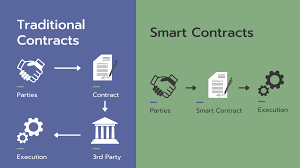
However, blockchain might not be prepared to take on the task of worldwide IP protection for a few reasons.
Firstly, IP protection has not been standardized over all countries, meaning that a single global blockchain would need to negotiate regional differences in IP law. This would hugely impact the effectiveness and efficiency of the blockchain, because the smaller, separate blockchains would not have the authority and legitimacy that a global blockchain would have.
Secondly, although the information inside the blockchain would be untamperable, the blockchain itself does not ensure the integrity of the data entered in the first place. This would mean that a separate verification system would need to be established, to ensure that data entry into this IP blockchain would not be falsified.
As blockchain emerges, more and more countries have realized its potential leading to some projects using blockchain to update the intellectual property protection system.
In Europe, the European Union (EU) made use of the new blockchain to automatically save registered IP rights data in a manner in which a central data server is not required, this promotes the accommodation of priority claims, and allows an examinable and permanent record of IP rights registration. Since the EU does not include a law for copyright registration, the existence and even the ownership of copyrighted work could not be proved in the past. Nowadays, the blockchain stores the copyrighted work’s trail of data on the internet, which can be used for verification purposes, so as to allow the proof of ownerships and existence of work. Furthermore, the EU is planning to improve licensing opportunities by legitimating licenses automatically. In regards to the opposition of counterfeiting, EUIPO has launched the “Anti-Counterfeiting Blockathon Forum”, which aims to protect supply chains from counterfeit goods. For example, the government may require companies to register each good in a blockchain, such that each good or batch of goods becomes a unique token. Other parties like the manufacturing and packaging suppliers can be authorized by right holders to create and handle tokens on their behalf, thus recording events and information for their goods.
We can see that the first mentioned weakness of using blockchain can be mitigated by creating a collaborative blockchain over multiple countries, possibly with a helpful governing body, in this case, the EU, however, in the future, perhaps other international collaborations can be made.
In India, the Indian Patent Office (IPO) uses blockchain to smoothen patent processes such that innovative commercial ideas could be protected. However, it’s debatable whether or not blockchain-based inventions are eligible since The Delhi High Court, while interpreting the word per se in the case of Telefonaktiebolaget Lm Ericsson v. Intex Technologies (2015), ruled that “any innovation which includes a technical contribution or has a technical effect and is not solely a computer programme per se” is patentable. This interpretation was once again upheld by the single judge of the Delhi High Court in Ferid Allani vs Union Of India & Ors.(2019) ,wherein it was held “If the invention demonstrates a “technical effect” or a “technical contribution‟ it is patentable even though it may be based on a computer program.” Further, the judge also observed, “Innovation in the field of artificial intelligence, blockchain technologies and other digital products would be based on computer programs, however the same would not become non-patentable inventions – simply for that reason.” Nonetheless, a blockchain-AI-based ecosystem is responsible for IP protection in India, aiming to produce a straightforward and efficient procedure.
In the US, blockchains are used to protect businesses from larceny by testing imports. It records trade transactions in which individual details and trade secrets are enclosed safely using encrypted keys, thus enhancing communication between multiple companies safely. Also, the patent market could be more observable and malleable for all stakeholders, which helps users to recognize profitable chances and prevent business risks. Moreover, blockchains collect historical records all in one enrollment and allow smart contracts for an underlying asset, which improves the transparency of the US market. Although blockchain has decreased the time required to assess IPR violations, thus increasing the efficiency of the evaluation of IP-related documentaries, according to the proof-of-concept finished by the US Customs and Border Protection (CBP), with the funding of the Department of Homeland Security’s Science & Technology Directorate, implementation and documentation synchronization has been one of the concerns, and the time requirement is unclear to initiate new rules and regulations (US Customs and Border Protection, 2019).
All in all, blockchain could help streamline and decentralize the process of protecting people’s ideas and products and would particularly help smaller entrepreneurs to start protecting their ideas more efficiently and reliably, only having to trust computer code to protect them, rather than a third party organization.
5. Cybersecurity
In essence, it can be agreed that blockchain has a remarkable quality in ensuring trust via such fault-tolerant mechanisms. They allow sociability among networks, privacy, and efficiency-driven in a decentralized manner.
In recent years, as a population, we have grown to be more digitally inclined and advanced. Ranging from storing our bank details to aiding us in ordering goods for daily uses, technology provides efficiency, boosting our productivity. However, as it is now convention to rely on the internet for our needs, it is now paramount that our cyber security systems are in parallel with the ever-evolving digital world. Failure in this can lead to ransomware attacking sensitive digital fields, for example in healthcare or public administration, resulting in devastating data leaks. An event as such is the recent SolarWinds hacking in 2020, where infamous nation-state hackers indirectly applied malware to a major technical service (Oladimeji and Kerner, 2022). Due to the nature of this hack (where a third-party platform called Orion was used to access the organization’s systems and information), the hackers were able to impersonate users of the organization. The breadth of this attack resulted in US government departments suffering, as well as private companies such as Microsoft. From statistics collated by DataProt, cyberattacks have reached a hefty $6 trillion in damages this year (Jovanovic, 2022). It is questionable whether the financial investments made by companies, governments, and organizations into current cybersecurity systems are effective, considering severe cyberattacks are still possible. In this section of the paper, the versatility of blockchain in cybersecurity is explored – the uses of blockchain in certain online security scenarios will be discussed, to prove how blockchain-incorporated systems can improve online integrity, backup, and recovery more effectively compared to traditional security systems (Jovanovic, 2022).
Consensus Mechanisms
Issues related to the ledger synchronization in blockchain technology may be worrying. Since blockchain is utilized in a decentralized manner (omitting central authority) ledgers, or certain parts of ledgers, can be held by all or some participants in the network, depending on whether the network is public-non-permissioned, or more complex. For example, hyper ledger fabric, as permissioned blockchain, allows nodes to be separated into channels; at first glance, this may be risky as a participant may try to promote a dishonest version of their ledger, and could try to profit from it. Consensus mechanisms govern the manner in which blocks are stored and handled based on one valid version of the facts. They play “a key role in ensuring the network’s security, integrity, and performance.” Consensus mechanisms serve as an infrastructure to avoid situations where the reliability of a blockchain network is not guaranteed. There are different types of consensus mechanisms, such as Proof of Work, Proof of Stake, and Proof of Elapsed Time (Lage, 2019).
As stated by Nguyen et al, proof of stake provides a ‘leader’ based on “their stakes, i.e their contributions to the blockchain network”. The stake of the node is often the volume of digital assets that it holds or unloads. FTS algorithms have been adopted in a variety of PoS to maintain leader choice based on stake domination. The hash function in the algorithm produces an index from nodes, which the transaction history will determine the leader. This consensus mechanism is far less energy-consuming and efficient than its traditional alternative, for example, proof of work (PoW). PoS was initially designed to prevent further attacks from taking place in Bitcoin – its security means that a hacker will have to build a secret chain to destroy a $1.68 million coin over 7 blocks on PoS worth, $12 billion, which would take an immense amount of time. The attacker will also have to wait a year before being able to hack again (Nguyen et al., 2019).
Although ensuring harmony among blockchain networks like PoS, PoW has more disadvantages – the overwhelming element of competition makes PoW a less desired consensus mechanism. Utilized in cryptography such as bitcoin, the nature of the PoW algorithm (created in 2008) is to solve a digitally challenging problem in competition with the other participants in exchange for a reward. Once one participant discovers the solution, the rest of the participants can validate it, allowing the leader to insert another block into the chain. The nature of the process means that a participant with a higher hash rate than another participant may be more likely to become the leader. This puts the PoW at a disadvantage as the participants will compete to have high hash rates to heighten their chances of receiving incentives, resulting in high energy consumption. Some may even overlook the decentralized nature of consensus mechanisms altogether and will join mining pools to gain incentives. To put the remarkable energy consumption into perspective, the energy use of bitcoin was expected to exceed that of Denmark by 2020 (Zhang and Chan, 2020)
An example of applications of consensus mechanisms is in IoV. In the Internet of vehicles networks (IoV), mass data is communicated between nodes to improve the quality of services. Obvious major security issues prevail as centralized authorities are the IoVs dependency, making cyber attacks and malfunctions more likely to happen. Thus, the decentralization of PoS is perfect for such networks as there will not be as many vehicles joining and leaving the network. However, PoS is the only consensus mechanism fit for IoVs as PoW requires many computers and has limited capacity, and delay is more likely (Larimer, 2013)
In recent years, blockchain has emerged as one of the safest, most secure technologies due to its trustless system, consensus mechanism, anonymity, and data integrity. This paper researches the applications of blockchain and cybersecurity and exposes technical limitations and challenges such as security requirements, technology testing, and more. In order to solve these issues, the article explores the current state of blockchain and the advantages of its use in a variety of different fields. One such advantage is the “tamper-proofing” of blockchain (see figure 2). When a transaction is made, a timestamp to go along with it will be created at the same time. After this timestamp is created, changes that happen before that timestamp will be invalid. Additionally, for this transaction to go through, there is a consensus mechanism in place, such that a certain percentage of users have to approve the transaction, which is typically 50% or more (Dai, 2018).
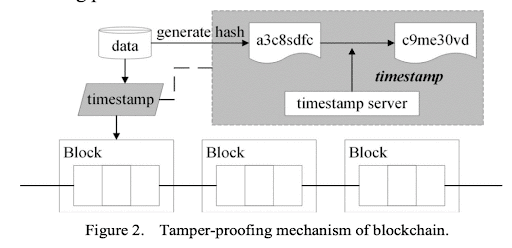
Encryption
With the rise of social media, hackers have become increasingly prevalent, and have been able to gain access to heaps of data like never before. With blockchain, we can replace unreliable passwords with secure, end-to-end encryption. Encryption is the process of “converting information or data into a code especially to prevent unauthorized access” (Cizmeci, 2021). Essentially, the aim of encryption is to make the data unrecognizable by converting it into an alternative text that is encrypted and secure. When a user wishes to access that data they can use a special key to decrypt it and gain access to it.
This will also allow for private messaging to become safer (Singh, 2021). BIM (Building Information Modeling) is crucial in key public projects such as government buildings, prisons, and more, and can also help “Visual risk analysis and safety evaluations… over the course of the project execution” (Hall, 2018). As a result, any leaking of confidential data could be catastrophic. Blockchain technology can create encryption protocols to help aid BIM security, and better protect this technology. Blockchain can be utilized by recording BIM changes in a “tamper-proof ledger.” (Das et al., 2021).
Benefits
Whether they are public or private, vendors present blockchain as a service (Banerjee, 2021). One such vendor is Amazon Web Services, where participants are invited to join the private network. Another popular vendor is IBM Blockchain, a type of hyper ledger fabric (Bhuvana, 2020). This deployment mechanism offers stability in blockchain networks and simplifies them. It is a well-liked vendor as it regulates trustworthy identity online (Lage, 2021).
Transactions in blocks are cryptographically held by the sender and its miner – this means that every block has a hash of the incoming block and all the participants of the chain as a truth. This ensures security, as a hacker will gain more than 50% of the network participant’s trust, as well as completing the block’s consensus challenge. To further ensure honesty within networks, merkle trees are a significant step forward for future cybersecurity.
Cyberthreats are more dangerous than ever before, and we need a safe, secure method to be able to effectively protect ourselves. One expert writes: “blockchain characteristics such as decentralization, verifiability, and immutability can facilitate one to achieve authenticity, reliability, and integrity of data” (Parizi et al., 2020). While all these benefits seem very exciting, we have yet to overcome hurdles surrounding the implementation of blockchain technology in the current digital world (Parizi et al., 2020). On a similar note, due to the rise of the internet, privacy leaks, and ransomware attacks have been becoming more and more prevalent. These cyber-attacks cost, on average, $4.24 million for companies around the globe (IBM, 2020). Blockchain can easily fix these problems, thanks to its decentralized nature. To be able to compromise data, hackers would have to gain control of the majority of nodes, which is extremely costly and time-consuming. Instead of all the data being centered around one single authority, it can be dispersed to multiple nodes, making transactions more secure. Blockchain can also protect individual internet users, by providing “users a decentralized online identity that shields their personal data against breaches.” Digital identity wallets empower users to have full control and access over all their data. They have all their formal identifications stored in one, secure place, and they also have the ability to grant and deny access to others who want their info. This allows for a “more secure way to share their information” (IBM, 2022). Besides protecting online users, blockchain can also aid in protecting systems, more specifically, smart home devices. With more and more people getting smart home systems, it has become increasingly easy for hackers to gain access to these smart home devices. Blockchain can easily fix this issue by using its inherent decentralized nature on administrative systems, which can also lead to a decrease in DDoS attacks. This can apply to almost anything, as nowadays we typically use centralized storage systems to protect large quantities of data. This is ineffective, as if hackers gain access to a small chunk of that data, they can then easily gain access to all of it. By storing data in a decentralized manner, it will be near impossible for hackers to gain access to all the data at once (Singh, 2021).
Vulnerabilities and Disadvantages
While blockchain does show some promising security abilities, it is not completely immune to hackers, data breaches, and other possible security threats. A survey conducted by Hasanova et al. investigates and “extends upon the previous studies on vulnerabilities” within blockchain. This survey looks at the disadvantages and vulnerabilities. While blockchain’s encryption technology seems sufficient to withstand hacking, there have been examples of data breaches in the past. Blockchain certainly has infinite possibilities, but there are still many hurdles to overcome before it becomes a widely implemented technology (Hasanova et al., 2019).
6. Cybersecurity
The world and aspects surrounding blockchain are intimidating to the average curious individual. With such a new concept, there is little research for one to grasp the impact fully and implications blockchain has on society. When researching the various applications of blockchain, their effects and influence on the economy and finances stood out. One could view blockchains as a public ledger where all committed transactions are stored in a chain of blocks (Zheng, Ning Dai, Xie, 2018). Ultimately, blockchains can help improve any financial process, which will help pave the way for “a new economic system where agreed-upon transactions can be enforced autonomously to rules defined in the contract” (Beck, Müller-Bloch, Leslie King, 2018).
When investigating blockchain technology and its impact on the economy, smart contracts and distributed ledger are two terms that consistently reappear. Philip Treleaven, Richard Gendal Brown, and Danny Yang (2017) define a smart contract as a way to constitute “the rules that participants have collectively agreed upon to govern the evolution of “facts” in the distributed ledger”. Using the same source, “a distributed ledger is a decentralized, shared, replicated, and synchronized record of transactions between contracting parties secured by cryptographic sealing” (Trevleaven, Gendal Brown, Yang, 2017). It is important to note that not all distributed ledgers are blockchains, but all blockchains are distributed ledgers. In terms of a smart contract, pairing such a contract with blockchains that can record changes in asset ownership, a smart contract can serve as a protection for the transaction that automatically moves value and executes the contract’s terms (Trevleaven, Gendal Brown, Yang, 2017). The impact of this partnership between blockchains and smart contracts will help eliminate the use of third-party officials; this is because the computers or systems that connect to the blockchain can validate the transaction per the rules of the smart contract. After all, they operate using distributed open source protocols; no further verification is needed, which prevents the need for a third-party operation to execute transactions (Trevleaven, Gendal Brown, Yang, 2017). The relationship between smart contracts and blockchains could help build a new framework for private records, helping to lead the rise of new corporations specializing in such fields of study. This rise will eventually eliminate third-party contracts and verification, establishing a new blockchain-based economy.
Furthermore, regarding the impact of blockchains on finances and financial markets, it is vital to establish whether blockchains can resolve market failures and if they can increase market efficiency and welfare. Min Xu, Xingtong Chen, and Gang Kou describe how, through their research, they found how “the application of blockchain technology to streamline transactions and settlement processes can effectively reduce the cost associated with manual operations” (Xu, Chen, Kou, 2019). The authors use examples of different industries and the benefits of blockchain applications; for example, the healthcare sector can centralize research data to help avoid prescription drug fraud. Blockchain will further improve the accuracy and availability of copyright data in the music industry (Xu, Chen, Kou, 2019). The image below indicates all the industries blockchains could financially affect; with computer science being the largest due to its abilities in the digital macroeconomy (Xu, Chen, Kou, 2019).
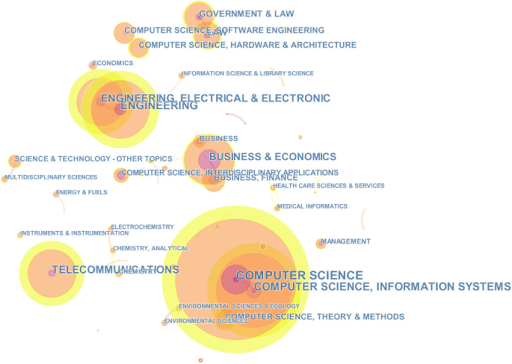
Such a range of improvements further suggests how blockchain holds an economic value which can help be identified through four typical applications:
- Digital asset registries
- Leapfrog technology
- Long-tail personalized economic services
- Payment channels and peer banking services
(Swan, 2017). Swan suggests, “First considering digital asset registries, there are a number of projects underway, particularly for improved efficiency in land titling and birth registration. Second, blockchains are identified as an important leapfrog technology for global financial inclusion with eWallet banking services, identity registration, and land titling. Third, distributed ledgers might allow personalized economic services to be created such as non-standard mortgages to suit individual needs in digital marketplaces that are like an “eBay for money”. Fourth, a speculative technology called payment channels might eventually develop into a digitized payment system for resource consumption that settles based on net payments instead of gross transfers, and enables peer-to-peer banking services” (Swan, 2017). The applications will allow companies to streamline their core business, reduce transaction costs, and make intellectual property ownership and payments more transparent and automated (Felin, Lakhani, 2018). With organizations’ abilities to handle financial issues with an adjustable system by holding, transferring, and issuing digital currencies that are based on blockchain technology, market efficiency and welfare will be able to become more effective due to the protection behind blockchain technology. Supporting how the impact of blockchains on finances and the financial market will help resolve market failures.
It is evident that blockchains have a substantial impact on many sectors of the macroeconomic realm. Blockchain can revolutionize our world; it affects various industries such as healthcare or the music industry, and it is apparent the future is blockchain.
7. Public Finance
Governments disburse millions of dollars to programs and courses like arts, social assistance, and education. The process in which they do so is very inefficient and causes money to be lost in the process of going through the bank. Blockchain can eliminate corruption because it reduces the steps involved and the costs governments have to go through. It is a based accounting system which provides permanent and faster reconciliation. It also lowers redundancy, improving efficiency. The technology removes illegal siphoning as it reduces the number of parties involved in the grant disbursements which helps the transparency and trust in grant disbursements. Besides, blockchain being used by the government to eliminate exorbitant costs also helps the government build trust by monitoring trust funds and loans. The World Bank Group Finance and Accounting, WFA, and Trust Fund and Loans, TL, department has authority to monitor the disbursements made under the Bank. It implements necessary commands to ensure the fiduciary mandate makes sure The World Bank sees the proceeds of Bank loans are only used for the purpose intended. The Bank also has financial responsibility for trust funds which are provided by donors. The Bank has the power to track disbursed loan amounts and expenditures for any Bank related project. The Bank also wants to make the funds within projects more transparent and access real-time information on the funds and how they are used. Blockchain comes into play because the Bank needs it to access real-time information. Blockchain allows The Bank to know where, when, and how the funds are used for expenditures, supply information on how the funds are actually spent, allow the ability to trace the funds across the disbursement chain through the Bank, and so gain more trust from the beneficiaries and countries involved with the Bank (The World Bank, 2021). Blockchain also helps the government secure identity management. States have to register each person’s identity which ensures protection against violation. However, this allows the dependency on a central authority like the Bank to be eliminated as the information will be through blockchain. In 2021, a Global Blockchain Survey by the company Deloitte involving blockchain and digital assets surveyed 1,280 senior executives. The company found 73% of the people believed that if they did not institute blockchain solutions, their company would have no competitive advantage. The US government seems to not be able to keep track of the pace of digitalization globally and most countries are falling behind. Corruption is increasing and the government would not be able to fight it without technologies like blockchain. The government spends hundreds of millions of dollars from taxes and so much time to use and store federal records. With blockchain, all this time and money will be saved, so governments should be fully converting electronically. Governments will have document history and be able to secure their data storage without having to spend countless hours in doing so. Every piece of information which is being added to the blockchain is time-stamped and unchangeable – the only way to change something is to add a new version, but the old one will not be deleted. Blockchain can also build trust with the government and the people. In the US, according to a Pew Research Center Report, only 24% of citizens trust the federal government. Blockchain will increase that number because it focuses on transparency. The data is visible to everyone and even if the data is meant to be personal it can be shared anonymously. No matter which way, people would be able to see everything with no middle man or an authority blocking them from understanding where their taxes are going or what the government is doing. People will trust the government more because there will be no secrets, only transparency, and the government can use all the money being saved, due to not having to be the middleman, to provide more for the people and give them things such as better education. It becomes a win-win situation for the people and the government; thus blockchain is essential.
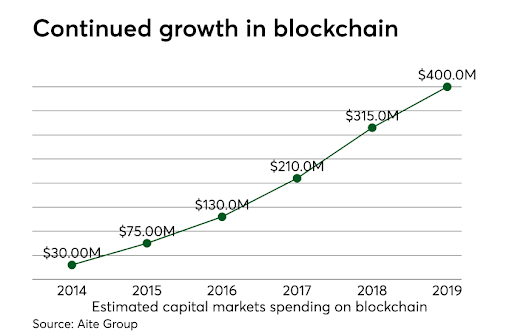
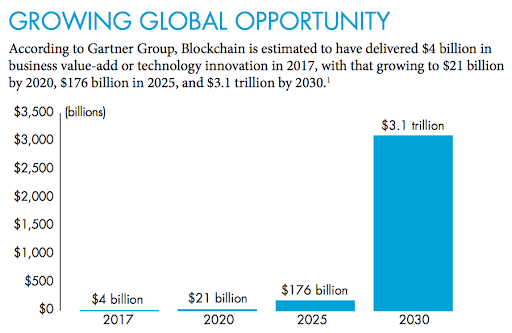
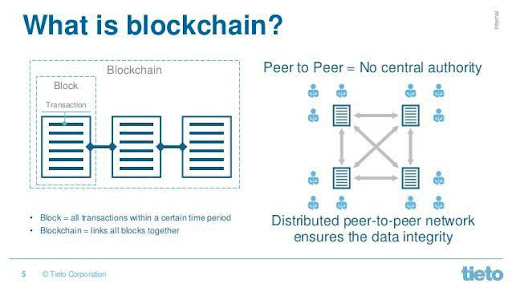
8. Cross Border Transactions
Blockchain technology makes cross-border transactions safe and efficient. It is secure and improves transparency making tracking easier. When a user creates a transaction, the transaction is a “block” and this is broadcasted. The network nodes have to approve this and then this block gets added to a chain which is entered on the ledger. Transactions between countries is what makes the global economy prosper. Blockchain removes all unnecessary steps and inefficiencies that make this transaction inconvenient.
Although sending money locally through services like Venmo is relatively simple, sending money internationally gets really complicated.
Right now, SWIFT (Society for Worldwide Interbank Financial Telecommunications) is the main framework used for global transactions. It sends about forty-two million messages daily. This system takes about an average 6.75% fee per transaction and has many delays (CNBC, 2022). The European Union and 19 countries all follow SWIFT. A big problem with the way things are now is the security breaches that come with having so many steps. Hackers stole eighty-one million from the Central Bank of Bangladesh (Klebanov, 2021). After they got into the SWIFT financial system, they sent cash to their accounts in Sri Lanka and the Philippines. This shows how hackers are learning the intricacies of the global banking system and how to dominate it.
Blockchain technology allows a quicker and more secure process. It bypasses a lot of the in between lengthy steps and records these transactions in a distributed ledger. This ledger is hard to modify without the approval of all parties involved so it decreases any security risks.
A lack of familiarity with blockchain could be holding it back. If consumers feel that they are not comfortable with this relatively new system, they might not adopt it. But still, the world is starting to feel more open towards it by creating regulatory frameworks for it. After starting the digital yuan, China has created the first central-bank digital currency. Russia has finally legalized crypto-currency trade. Governments are starting to embrace this industry which will lead to a more global adoption.
Libra is a primary example of blockchain technology innovation that did not work.
Libra was Facebook’s attempt to make a cryptocurrency. Huge companies like Uber and Mastercard backed this up. If Libra works, then banking and transactions will be so much more accessible for the whole world. Having almost 3 billion users, Facebook could change our global financial system drastically. Since it is a private cryptocurrency, there is no legitimate authority that can oversee it, unlike the Federal Reserve in relation to regular banks.
Facebook’s reputation only worsened their proposal in the eyes of the government. This was because of their privacy and censorship issues. It did not make them trustworthy and capable of running Libra. Because it would be privatized, countries and banks worried that they would lose control of policies and the economy. Before Libra even started, India had already said it might ban it because they prohibited digital currency already (Telford 2019). What started this downfall was that Facebook was not ready to talk about the concerns people were bringing up, such as money laundering and consumer protection. Libra eventually had to shut down.
Binance is an example of blockchain that works successfully. It’s the largest exchange of cryptocurrencies in the world. They have made their own blockchain called the “Binance chain” and its own token called the “Binance Coin”. Its rates are relatively low making it one of the most viable options for cross-border transactions. It is widely accessible in over 180 countries and having over 600 cryptocurrencies.
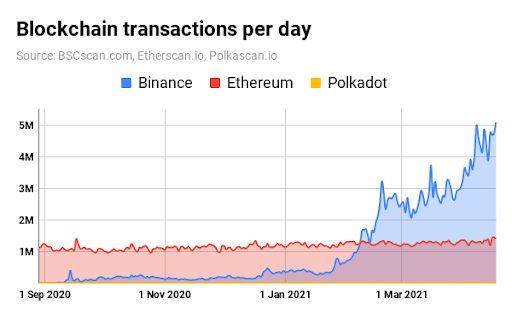
9. Government
As a revolutionary technology, blockchain is impacting enterprises and businesses in many ways, but its impact on governments and the public sector cannot be underestimated, and its versatility allows it to be used in multiple niche markets.
Why is blockchain used by governments and the public sector?
Governments and the public sector are complex infrastructures. Blockchain can be used in existing systems to improve the efficiency and reliability of public service delivery. Blockchain technology is good at simplifying the original cumbersome processes in the public sector and improving the transparency and accountability of the government and the public sector. Blockchain technology has timely and uninterrupted information records, which can reduce fraud and mistakes.
There are three main uses of blockchain technology in the public sector: digital identity management and maintenance of registries (Das, 2020). Blockchain technology excels in digital identity management in the public sector, as it ensures that all digital identities are encrypted and secured. The technology follows a decentralized approach to identity management, which helps eliminate existing problems such as lack of accessibility, data insecurity, and fraudulent identity. In the management of various government registries, blockchain technology provides the transparency needed to eliminate fraud and corruption and speeds up notoriously slow and cumbersome procedures.
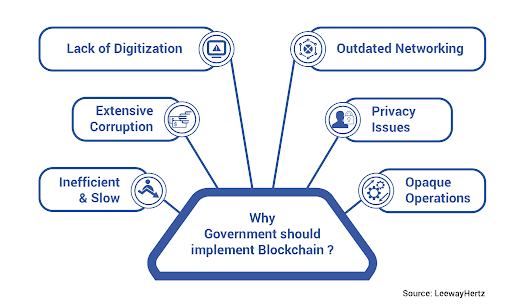
Cooperation between blockchain projects and governments
Governments around the world are adopting blockchain technology to provide better public services, and governments are trying to build a paperless, secure, and highly transparent system through blockchain. The three most popular projects are Full form (RSK), Full form (ICON), and Power Ledger (Sharma, 2020). They have different functions, features, and uses. RSK focuses on providing Bitcoin blockchain smart contract functions. ICON features a decentralized network that connects multiple blockchains from around the world, solving the puzzle of spatial interoperability. Power Ledger is an energy trading platform for the decentralized buying and selling of renewable energy. And how exactly do they cooperate with the government? The Central Bank of Argentina (BCRA) is currently developing a proof of concept (PoC) powered by RSK technology. The PoC focuses on implementing a decentralized platform that allows end-to-end traceability of account debit claims, through which various participants in the financial system can conduct more secure and reliable transactions. ICON is the government’s leading blockchain technology partner and is working on several government-backed projects in the insurance, healthcare, customs services, and education industries. Best of all, ICON and South Korean software company Cyberdigm have teamed up to develop a blockchain-based contract platform called Chain Sign, designed to digitally sign legally binding contracts, and the project has proven its tamper-proof security, and cost efficiency. Power Ledger is a peer-to-peer energy trading software designed to build an operating system for the new energy market. Among them, Power Ledger has partnered with Thai renewable energy company BCPG and Thai utility Metropolitan Electricity Authority (MEA) to trade rooftop solar to meet energy demand.
10. Encryption Security
Blockchain could facilitate government activities through its decentralized ledger secured through the RSA algorithm, utilizing secret and public keys for encryption, decryption, and digital signatures procurement, along with proof of work methods and computational work done by computer systems. This could find its primary use focusing on how funds are spent in the policymaking branch (executive and bureaucracy) and tracking the voting history of lawmakers in the legislatures to help decrease waste, detect fraud, limit extensive bureaucracy, make taxation efficient, and increase accountability.
Blockchain’s biggest application in government would be in bureaucracy. Using smart contracts designed to instantaneously track how the government’s budget is being spent through the executive branch for running the many different agencies involved, we can detect fraud and wasteful spending and also limit unnecessary spending.
It has been recorded that approximately $150 billion of US government money is lost to fraud, waste, or abuse every year as a result of lax policies or failed enforcement of anti-corruption measures (McKinsey & Company, 2018). The figures for the rest of the world are probably even higher, especially in countries that lack regulation or oversight in many respects when it comes to spending. Introducing blockchain specifically to monitor how these funds are being managed, distributed, and spent can reduce the overall amount of taxpayers’ money lost. Creating multiple blockchains for the different departments and agencies of the bureaucracy can also make tracking of the funds easier to follow.
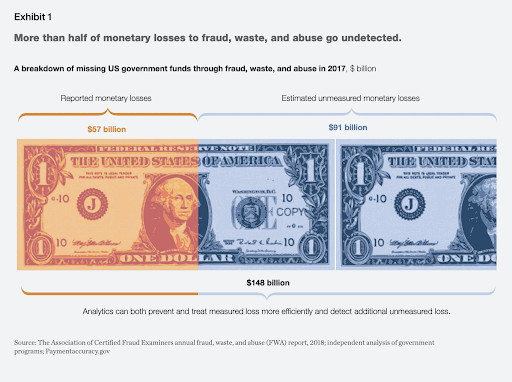
As well as increasing oversight of governments, governments can implement blockchain technology for purposes surrounding taxation, especially tax evasion. It is noted that around $381 billion is lost due to mass tax evasion in the US alone (Mitrova 2022). Those figures will be higher worldwide, especially in countries that lack enforcement of policies. The IRS and equivalents can use blockchain and smart contracts to closely monitor taxes collected from households and businesses. They can also create multiple chains directed to specific industries or corporations that have a track record of tax repatriation abroad or utilizing loopholes to avoid taxes. This implementation could be the first step toward to reducing inequality as well, since most tax avoidance is committed by wealthy individuals and businesses.
In addition to tracking wasteful government spending and tax avoidance, blockchain makes it more efficient to conduct these operations to begin with. Usually sifting through huge amounts of paperwork and records takes up time and manpower which adds to costs. With an instantaneous ledger system, these resources used to investigate can be targeted better to suspicious activities that show up on the chain, thus reducing costs and increasing efficiency.
Finally on the list is increasing public information on government activities. For civic duties to be carried out optimally, the public needs to have clear and easy access to information. Just as social media sites control the spread of misinformation, disinformation, and malinformation for the public’s interest; to be able to make the most informed decisions during election cycles, blockchain can also add a further layer of transparency for governments. Through blockchain, lawmakers’ voting history which is not often discussed publicly would be made more easily accessible for the general population to view. This informs the public on lawmakers’ stances on certain issues and can make people re-evaluate who they want to vote for in the coming election cycle. This increases government accountability and makes lawmakers consider their public image even more. This technology can be pushed even further to cover the decisions made by the presidents and their equivalents around the world. Whether it is a new policy on healthcare, or instructions for the military, amongst others, it puts everything that the government does in the public eye. Ideally, this will increase public participation and decrease apathy.
11. E-Voting
Blockchain technology creates online surroundings wherein voters’ security is secure. E-voting through blockchain allows voters to get live updates on which candidates have the most votes. This will save time with counting votes and reduce government expenses as they neither need to print ballots nor hire vote counters. E-voting is next to impossible to hack or manipulate due to all computers processing the data – meaning that if a certain ledger is different from the other ledgers containing the votes, the illegitimate ledger will be deleted.
On the other hand, there are problems in the E-voting sphere – one of which is that not all voters have access to a working computer. Namibia, a country in Africa, adopted E-voting in 2018. To counter this issue, Namibia set up voting booths around the country, allowing those who didn’t have access to a computer to vote. These voting booths were simple computers programmed to be able to take the voter’s ID and allow them to vote for the candidate of their choosing. Even though this cost millions of dollars to the Namibian government in 2018, it is predicted that Namibia will break even on the money spent in 2024. They are also granted more voter security and an easier voting process, since voters only need to log in to the government’s website and vote. In summary, E-voting is a blockchain technology that could save governments and associations millions of dollars while also granting them voter security, causing E-voting to be a blockchain technology that should be adopted in the future.
E-voting has many benefits other than voting security and financial benefits. Human resources are those who make up the workforce of an institution. E-voting can catalyze the process of the humans that need to count votes. For example, during the presidential election in the United States of America in 2016, roughly 25,000 people were employed to manually count votes. Even though Namibia from the previous example has a significantly lower population than the United States of America, they only required a workforce of 100 people to execute their plans. Not only does this save money, but it also saves many people time and energy. During the 2016 presidential election, there were several supervisors ensuring that the manual vote counters were being fair and honest. Voting through blockchain technology can eliminate all forms of human error, demonstrating that E-voting can be more accurate than manual voting while saving the time of those who manually count votes.
During the 2016 United States Presidential Election, the results were delivered 48 hours later than projected. During the 2019 Belgium Federal Election, there was a delay of more than five days for the results. Speed is an issue that also arises during manual voting. However, since E-voting instantly sends the voter’s selections into a ledger, there isn’t any delay. The results of the election will be available the moment voting closes.
One of the biggest advantages of blockchain voting is a higher voter turnout. Before Namibia used a blockchain voting system, they had 62% of those who could vote, voting. After adopting a blockchain voting system, they have an 84% voter turnout. People find it easier to vote online due to modern day society being technology-based. It is more convenient for someone to go to a government website and simply click on who they want to vote for over grabbing a ballot from the mail, filling it out, and then going to the closest ballot drop box. The time saved caused 22% of Namibia’s population to start voting. The more votes in an election, the more the election demonstrates popular sovereignty where the elected candidate is the best representative of the people’s needs. E-voting through blockchain could be regarded as a huge modern day breakthrough due to its ability to make voting more secure, the voting process quicker, lessen the amount of money spent by a government or association, and save human resources.
12. Central Bank Digital Currencies
Another use of blockchain technology in the government sector is the use of central bank digital currencies. The International Monetary Fund has classified a CBDC as a digital representation of a sovereign currency issued by a central bank or central monetary authority. Important attributes of central bank digital currencies include: being issued by the central bank or monetary authority of a country, backed by the central bank and can be exchanged for cash fiat currency, programmable for any use case (such as domestic and cross-border transactions) and considered as legal tender.
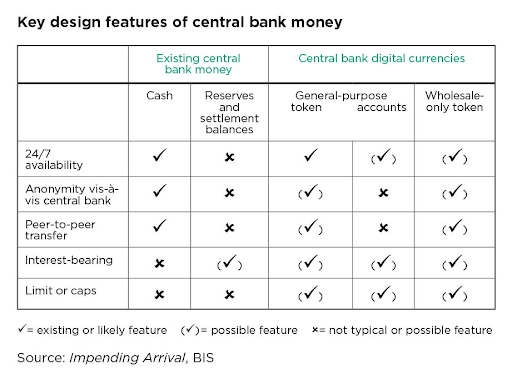
A retail CBDC is a digital payment token issued by a central bank meant to be used by the public. It would be the equivalent of a banknote and stored in a digital wallet. CBDCs would be transferable from person to person without an intermediary such as a commercial bank, therefore, mitigating counterparty risk. These transactions would be carried out on the blockchain technology presented by the central bank or monetary authority.
Other than reduced counterparty risk, CBDCs have many other benefits over cash fiat currency. Some of these are more efficient payments, improved traceability of money transfers, improved monetary policy, more financial inclusion and stability, increased competition and rises in consumption. Firstly, in terms of efficient payments, CBDCs can provide less costly and faster cross-border and domestic transactions. It can also reduce the costs of cash management. Secondly, since blockchain technology makes a record of all transfers executed with the tokens, there is improved traceability of money transfers. This will greatly aid financial data transmission and reporting of suspicious activities to central banks. It will also reduce money laundering and other illicit payments. Moreover, CBDCs can also improve monetary policy. CBDCs can be used as a powerful tool with interest rate policies. It would allow for the government to place negative or positive rates directly on the CBDC and even conduct helicopter money. In this way, it would help the transmission and effectiveness of the policies. Furthermore, CBDCs will also benefit those of lower socioeconomic backgrounds. It will ensure access to legal tender if cash is not available and in the case of token-based CBDCs, costly bank accounts will not be needed, encouraging more inclusivity. When the value of cash fiat currency is unstable it can also provide a safe haven for savings (financial stability). Additionally, CBDCs can be used to reduce the enormous market power of large private payment service providers. It can challenge them in retail deposits and therefore pressure them to improve financial services as well as interest rates. Lastly, a recent paper from the Bank of Canada showed that consumption could increase by 0.64% in Canada and 1.6% in the US with the introduction of CBDCs. This shows that CBDCs can also cause a rise in consumption within the country. To conclude, CBDCs can grant a country more efficient payments, improved traceability of money transfers, improved monetary policy, more financial inclusion and stability, increased competition and rises in consumption.
However, there are still several challenges to be mentioned when implementing CBDCs. These challenges are the disintermediation of commercial banks, the operational risks and the expenses. Firstly, there could be a big issue if citizens pulled too much money out of commercial banks at once to purchase CBDCs. This would cause a loss of funds for the banks, therefore affecting their ability to lend and sending a shock to interest rates. This will especially impact countries with already unstable financial systems. Secondly, there are operational risks such as cyber-attacks. Citizens may also have a problem with data privacy as the central bank would be able to see all of their transactions. Finally, CBDCs require a complex regulatory framework including privacy, consumer protection, and anti-money laundering standards which can be costly, timely, and difficult to develop.
Although there are many setbacks, the interest in CBDCs in the world is still sharply on the rise. 105 countries in the world (over 95% of global GDP) are exploring a CBDC. Additionally, 10 of the world’s countries have fully launched a digital currency and China’s pilot is set to expand in 2023. The JAM-DEX, issued by Jamaica, is the latest CBDC. Finally, 19 of the G20 countries are exploring a CBDC, with 16 already in the development stage. These countries include South Korea, Japan, India, and Russia. From this information, it is clear that although CBDCs come with many cons, the advantages largely outweigh them. As such, many countries are still interested in developing their own. With this large support, it then can be said that in the government sector, CBDCs are one of the most influential use cases of blockchain technology of our generation.
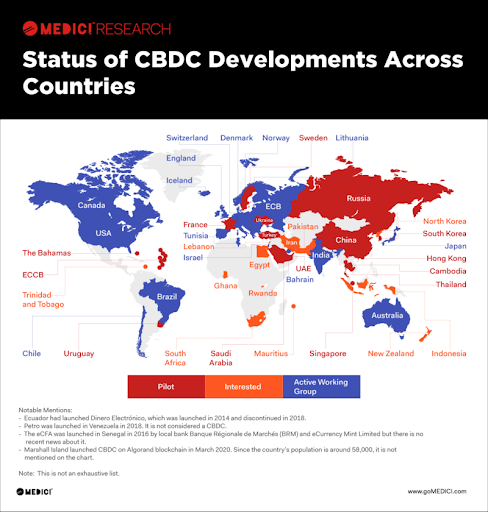
References
“CBDC Tracker.” n.d. Atlantic Council. https://www.atlanticcouncil.org/cbdctracker/.
Iredale, Gwyneth. 2021. “Advantages of Central Bank Digital Currencies (CBDCs).” 101 Blockchains. July 5, 2021. https://101blockchains.com/advantages-of-central-bank-digital-currencies/.
Arslanian, Henri. 2022. The Book of Crypto : The Complete Guide to Understanding Bitcoin, Cryptocurrencies and Digital Assets. Cham, Switzerland: Palgrave Macmillan.
R3, Amit Ghosh, Head of Asia Pacific at. 2020. “APAC Leads the Way on Central Bank Digital Currencies.” Fintech Singapore. October 7, 2020. https://fintechnews.sg/44173/fintech-opinion-leader/apac-leads-the-way-on-central-bank-digital-currencies/.
“How COVID-19 Is Driving Central Bank Currency Innovation | the Association of Corporate Treasurers.” n.d. Www.treasurers.org. Accessed August 20, 2022. https://www.treasurers.org/hub/treasurer-magazine/how-covid-19-driving-central-bank-currency-innovation.
Consensys. n.d. “Government.” ConsenSys. https://consensys.net/blockchain-use-cases/government-and-the-public-sector/.
“Blockchain Use Cases for Government I SettleMint.” n.d. Www.settlemint.com. https://www.settlemint.com/government-blockchain-use-cases/.
Cunningham, Susan, Mark Mcmillan, Sara O’rourke, and Eric Schweikert. n.d. “OCTOBER 2018 • PUBLIC SECTOR Cracking down on Government Fraud with Data Analytics.” https://www.mckinsey.com/~/media/McKinsey/Industries/Public%20Sector/Our%20Insights/Cracking%20down%20on%20government%20fraud%20with%20data%20analytics/Cracking-down-on-government-fraud-with-data-analytics-vF.pdf.
Mitova, Teodora. 2020. “19+ Tax Evasion Statistics You Shouldn’t Evade in 2021.” SpendMeNot. January 10, 2020. https://spendmenot.com/blog/tax-evasion-statistics/#:~:text=The%20resulting%20cost%20of%20tax
Asharaf, S., and S. Adarsh. Decentralized Computing Using Blockchain Technologies and Smart Contracts: Emerging Research and Opportunities. Hershey: IGI Global/Information Science Reference, 2017.
Modi, Ritesh. Solidity Programming Essentials: A Beginner’s Guide to Build Smart Contracts for Ethereum and Blockchain. Beginner’s guide to building smart contracts for Ethereum and blockchain: Packt, 2018.
Ng, Tsui S. “Blockchain and Beyond: Smart Contracts.” Business Law Today, 2017, 1–2. https://www.jstor.org/stable/27031184.
“Smart Contracts.” ethereum.org. Accessed August 21, 2022. https://ethereum.org/en/smart-contracts/.
Huang, Yan, Chengnian Long, and Jing Wu, “Drugledger: A Practical Blockchain System for Drug Traceability and Regulation”, Jul 2018 <https://www.researchgate.net/profile/Yan-Huang-30/publication/332859261_Drugledger_A_Practical_Blockchain_System_for_Drug_Traceability_and_Regulation/links/5ccd5b58299bf14d957656a2/Drugledger-A-Practical-Blockchain-System-for-Drug-Traceability-and-Regulation.pdf> [Accessed 20 August]
Bublitz, Frederico Moreira, Laura Xavier Fadrique, Plinio Pelegrini Morita, Pedro Elkind Velmovitsky, “Blockchain Applications in Health Care and Public Health: Increased Transparency”, Jun 2021 <https://pubmed.ncbi.nlm.nih.gov/34100768/> [Accessed 20 August]
Crespo, Rubén González, Haibing Liu, Oscar Sanjuán Martínez, “Enhancing Privacy and Data Security across Healthcare Applications Using Blockchain and Distributed Ledger Concepts”, Jul 2020 <https://pubmed.ncbi.nlm.nih.gov/32751325/> [Accessed 20 August]
Example of Paris company with blockchain applications <https://www.blockpharma.com/> [Accessed 27 August]
Example of U. S. A. company with blockchain applications <https://www.coralhealth.com/> [Accessed 27 August]
Attaran, M., Gunasekaran, A. (2019). Blockchain for Gaming. In: Applications of Blockchain Technology in Business. SpringerBriefs in Operations Management. Springer, Cham. https://doi.org/10.1007/978-3-030-27798-7_12
Pfeiffer, Alexander, et al. “Blockchain Technologies and Games: A Proper Match?: International Conference on the Foundations of Digital Games.” ACM Other Conferences, 1 Sept. 2020, https://dl.acm.org/doi/abs/10.1145/3402942.3402996.
Sharma, Toshendra Kumar. “Blockchain Technology to Be Implemented in Gaming Industry.” Web3 & Blockchain Certifications, Toshendra Kumar Sharma Https://Blockchain-Council.org/Wp-Content/Uploads/2022/02/Logo-500×96-1.Png, 22 Aug. 2018, https://www.blockchain-council.org/blockchain/blockchain-technology-to-be-implemented-in-gaming-industry/.
Takahashi, Dean. “Newzoo: Games Market Expected to Hit $180.1 Billion in Revenues in 2021.” VentureBeat, VentureBeat, 30 Apr. 2018, https://venturebeat.com/business/newzoo-global-games-expected-to-hit-180-1-billion-in-revenues-2021/.
Saraswat, Anuja, “Patent applications for blockchain technology : A Comparative Study Between India And U.S.A”, Mar 2022 <https://www.iiprd.com/patent-applications-for-blockchain-technology-a-comparative-study-between-india-and-u-s-a/> [Accessed 20 August]
King, Brittany, “AI and Blockchain help discover and transact IP”, May 2021 <https://www.ibm.com/case-studies/ipwe/> [Accessed 20 August]
S. A. Business Transformation and Innovation Division, Sep 2018 <https://www.cbp.gov/trade/ace/whats-new-innovation> [Accessed 20 August]
S. A. Intellectual Property Rights Blockchain Proof of Concept: Overview & Results, Mar 2020 <https://www.cbp.gov/sites/default/files/assets/documents/2020-Mar/IPR%20POC%20Report%20-%20Final%20V2.pdf> [Accessed 20 August]
Blockchain application in the field of ip, Jul 2018 <https://talkingtech.cliffordchance.com/en/emerging-technologies/blockchain—distributed-ledgertechnology/blockchain-and-its-application-in-the-field-of-ip.html> [Accessed 20 August]
EUIPO European Union Intellectual Property Office <https://euipo.europa.eu/ohimportal/en/news/-/action/view/8662923> [Accessed 20 August]
Intellectual property law and practice in the blockchain realm https://www.sciencedirect.com/science/article/abs/pii/S0267364 [Accessed 20 August]
https://originstamp.com/blog/blockchain-and-intellectual-property-rights-protection-technology/ [Accessed 20 August]
https://www.wipo.int/wipo_magazine_digital/en/2020/article_0002.html#:~:text=Blockchain%20technology%20can%20also%20potentially,if%20applicable [Accessed 20 August]
Banerjee, Avinandan. “The State of Blockchain Applications in Cybersecurity -.” Web3 & Blockchain Certifications | Online Training & Courses | Blockchain Council, https://www.facebook.com/blockchaincouncil/, 9 Aug. 2021, https://www.blockchain-council.org/blockchain/the-state-of-blockchain-applications-in-cybersecurity/.
Bhuvana, R., and P. S. Aithal. “Blockchain-based service: A case study on IBM Blockchain Services & Hyperledger Fabric.” International Journal of Case Studies in Business, IT, and Education (IJCSBE) 4, no. 1 (2020): 94-102.
Cizmeci, Daglar. “Blockchain Encryption: What Is It and How It Works.” DaglarCizmeci, DaglarCizmeci, 24 Dec. 2021, https://daglar-cizmeci.com/blockchain-encryption/#:~:text=Blockchain%20encryption%20is%20the%20prevention,must%20be%20very%20much%20protected.
Dai, Fangfang, Yue Shi, Nan Meng, Liang Wei, and Zhiguo Ye. “From Bitcoin to cybersecurity: A comparative study of blockchain application and security issues.” In 2017 4th International Conference on Systems and Informatics (ICSAI), pp. 975-979. IEEE, 2017.
Das, Moumita, Xingyu Tao, and Jack CP Cheng. “BIM security: A critical review and recommendations using encryption strategy and blockchain.” Automation in Construction 126 (2021): 103682.
Hall, John. “Top 10 Benefits of BIM in Construction.” BIM 360 Resource Center, Resource Center, 27 July 2018, https://bim360resources.autodesk.com/connect-construct/top-10-benefits-of-bim-in-construction.
Hasanova, Huru, Ui‐jun Baek, Mugon Shin, Kyunghee Cho, and Myung‐Sup Kim. “A survey on blockchain cybersecurity vulnerabilities and possible countermeasures.” International Journal of Network Management 29, no. 2 (2019): e2060.
Jovanovic, Bojan. “Better Safe Than Sorry: Cyber Security Statistics and Trends for 2022.” Dataprot, 20 July 2022, https://dataprot.net/statistics/cyber-security-statistics/.
Larimer, Daniel. “Transactions as proof-of-stake.” Nov-2013 909 (2013).
Lage, Oscar, Santiago de Diego, Borja Urkizu, Eneko Gómez, and Iván Gutiérrez. “Blockchain applications in cybersecurity.” Computer Security Threats (2019): 73.
Nguyen, Cong T., Dinh Thai Hoang, Diep N. Nguyen, Dusit Niyato, Huynh Tuong Nguyen, and Eryk Dutkiewicz. “Proof-of-stake consensus mechanisms for future blockchain networks: fundamentals, applications, and opportunities.” IEEE Access 7 (2019): 85727-85745.
Oladimeji, Saheed, and Sean Kerner. “SolarWinds Hack Explained: Everything You Need to Know.” WhatIs.Com, TechTarget, 29 June 2022, https://www.techtarget.com/whatis/feature/SolarWinds-hack-explained-Everything-you-need-to-know.
Parizi, Reza M., Ali Dehghantanha, Amin Azmoodeh, and Kim-Kwang Raymond Choo. “Blockchain in cybersecurity realm: an overview.” Blockchain Cybersecurity, Trust and Privacy (2020): 1-5.
Singh, Surajdeep. “Potential Use Cases of Blockchain Technology for Cybersecurity | ITBE.” IT Business Edge, https://www.facebook.com/ITBusinessEdge, 16 July 2021, https://www.itbusinessedge.com/security/potential-use-cases-of-blockchain-technology-for-cybersecurity/.
Thomas, Ciza, Paula Fraga-Lamas, and Tiago M. Fernández-Caramés, eds. Computer Security Threats. BoD–Books on Demand, 2020.
Work, Innovation. “IBM Report: Cost of Data Breaches Soars to All-Time High During Pandemic – IEEE Innovation at Work.” IEEE Innovation at Work, https://www.facebook.com/ieee.continuing.education/, 3 Aug. 2021, https://innovationatwork.ieee.org/ibm-report-cost-of-data-breaches-soars-to-all-time-high-during-pandemic/.
Zhang, Rong, and Wai Kin Victor Chan. “Evaluation of energy consumption in block-chains with proof of work and proof of stake.” In Journal of Physics: Conference Series, vol. 1584, no. 1, p. 012023. IOP Publishing, 2020.
Mohan, Arun Prasad, and Angelin Gladston. “Merkle tree and Blockchain-based cloud data auditing.” International Journal of Cloud Applications and Computing (IJCAC) 10, no. 3 (2020): 54-66. https://www.igi-global.com/article/merkle-tree-and-blockchain-based-cloud-data-auditing/256864
Treleaven , Philip, Richard Gendal Brown , and Danny Yang . “Blockchain Technology in Finance.” IEEE Xplore. IEEE, September 22, 2017. https://ieeexplore.ieee.org/abstract/document/8048631/.
Wang, Huaimin, Shaoan Xie, Hong-Ning Dai, and Zibin Zheng . “(PDF) Blockchain Challenges and Opportunities: A Survey – Researchgate.” Blockchain Challenges and opportunities: a survey . International Journal of Web and Grid Services , 2018. https://www.researchgate.net/publication/328271018_Blockchain_challenges_and_opportunities_a_survey.
Beck, Roman, Christoph Müller-Bloch, and John Leslie King. “Governance in the Blockchain Economy: A Framework and Research Agenda.” AIS Electronic Library (AISeL). eLibrary , October 31, 2018. https://aisel.aisnet.org/jais/vol19/iss10/1/.
Xu, Min, Xingtong Chen, and Gang Kou. “A Systematic Review of Blockchain – Financial Innovation.” SpringerLink. Springer Berlin Heidelberg, July 4, 2019. https://link.springer.com/article/10.1186/s40854-019-0147-z.
Swan, Melanie. “Anticipating the Economic Benefits of Blockchain.” Technology Innovation Management Review. Technology Innovation Management Review , January 1, 1970. https://timreview.ca/article/1109.
Felin, Teppo, and Karmin R Lakhani. “What Problems Will You Solve with Blockchain? D – Researchgate.” What problems will you solve with blockchains?, October 2018. https://www.researchgate.net/profile/Teppo-Felin/publication/328598250_What_problems_will_you_solve_with_blockchain/links/5d1d26e1a6fdcc2462bdb287/What-problems-will-you-solve-with-blockchain.pdf.
“Blockchain for Government – IBM Blockchain.” IBM. Accessed August 31, 2022. https://www.ibm.com/blockchain/industries/government?utm_content=SRCWW&p1=Search&p4=43700068275641643&p5=e&gclid=067fa02e579b1617a210c2c0c9b1c96b&gclsrc=3p.ds
Currency, FE Digital. “Financialexpress.” The Financial Express Stories, August 6, 2022. https://www.financialexpress.com/digital-currency/how-can-governments-make-use-of-blockchain-oriented-solutions/2619993/
“Blockchain for Loans Disbursement Traceability (BLDT Platform).” World Bank. Accessed August 31, 2022. https://www.worldbank.org/en/about/corporate-procurement/business-opportunities/administrative-procurement/blockchain-for-loans-disbursement-traceability-bldt-platform
Team, PixelPlex. “How Blockchain Is Used in Government Processes.” PixelPlex. PixelPlex, July 9, 2021. https://pixelplex.io/blog/blockchain-in-government-processes/
Copper. “Who Will Win the Blockchain Wars: Binance Smart Chain vs Polkadot vs Ethereum.” Copper, May 9, 2021. https://copper.co/insights/who-will-win-the-blockchain-wars-binance-smart-chain-vs-polkadot-vs-ethereum.
Telford, Taylor. “Why Governments around the World Are Afraid of Libra, Facebook’s Cryptocurrency.” The Washington Post. WP Company, July 12, 2019. https://www.washingtonpost.com/business/2019/07/12/why-governments-around-world-are-afraid-libra-facebooks-cryptocurrency/.
Klebanov, Sam. “A Look at Blockchain in Cross-Border Payments.” PaymentsJournal, February 5, 2021. https://www.paymentsjournal.com/a-look-at-blockchain-in-cross-border-payments/.
Webber, Daniel. “Cryptocurrency in Cross-Border Payments: After COINBASE’s Success, Can Crypto Flourish beyond Assets?” Forbes. Forbes Magazine, April 23, 2021. https://www.forbes.com/sites/danielwebber/2021/04/21/cryptocurrency-in-cross-border-payments-after-coinbases-success-can-crypto-flourish-beyond-assets/.
“How Do Crypto Cross-Border Payments Work?” cnbctv18.com, March 24, 2022. https://www.cnbctv18.com/cryptocurrency/how-do-crypto-cross-border-payments-work-12922362.htm.
Sharma, Toshendra Kumar. “How Blockchain Projects Are Collaborating with Government?” Web3 & Blockchain Certifications. June 14, 2020 https://www.blockchain-council.org/blockchain/how-blockchain-projects-are-collaborating-with-government/.
Das, Vikash Kumar. “Blockchain Adoption in Government and Public Sector.” Web3 & Blockchain Certifications. December 1, 2020 https://www.blockchain-council.org/blockchain/blockchain-adoption-in-government-and-public-sector/.
Takyar, Akash. “A Detailed Insight into Blockchain Government Initiatives.” LeewayHertz, July 8, 2022. https://www.leewayhertz.com/blockchain-government-public-sector-initiatives/.
https://dl.acm.org/doi/abs/10.1145/3439725
https://www.mdpi.com/2073-8994/12/8/1328/htm
https://ieeexplore.ieee.org/abstract/document/8862743
https://dzone.com/articles/how-blockchain-development-is-making-data-more-sec
https://medium.com/@cheonmyung0217/what-is-blockchain-30a0a6166417




